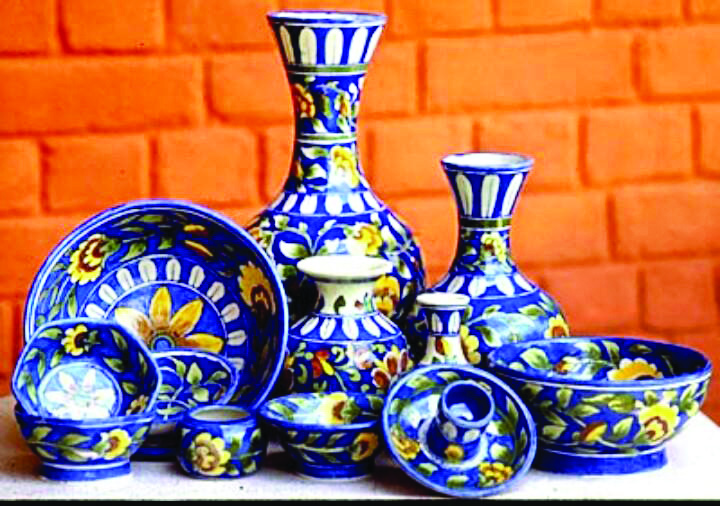An art with ubiquity
Originated in Central Asia, the iconic Jaipur Blue Pottery has managed to retain its radiant colour and traditional motifs over the ages, and has found its niche beyond museums — into households and kitchenware

One of India’s most popular tourist destinations and UNESCO’s world heritage site, the Pink City of Jaipur attracts visitors to its iconic places like the Amer Fort and Jantar Mantar. It is also the home to an absolutely affordable, functional and aesthetic cultural artefact, the Jaipur Blue Pottery (JBP). JBP is not only part of the world’s best museums, but it also adorns verandas, homes and kitchens of many middle-class households across the country, and perhaps the world.
Believed to be of Central Asian origin, the iconic Blue pottery of Jaipur can be easily recognized by the predominance of blue colour on all the products. The brilliance of blue created from cobalt oxide is striking and is the key shade to create the visual appeal of these items. The use of yellow, green and other colours also enhances the traditional colour palette of white and blue. Over the centuries, it has retained its Chinese, Persian, Turkic, Mughal and Arabesque patterns and motifs of birds and animals, but added to its repertoire court and hunting scenes, as well as the imagery of popular Hindu icons – the deity Hanuman, the goddess Saraswati and the Ram Darbar.
JBP is made out of low-fired, glazed ceramic. The ‘dough’ for the pottery is prepared by mixing quartz stone powder, powdered glass, ‘Multani Mitti’, borax, gum and water. Another source cites ‘Katira Gond’ powder (a gum), and ‘saji’ (soda bicarbonate) as ingredients. The dough is rolled and flattened into a thick ‘Chapati’ (pancake) and placed in molds with a mixture of pebbles and ash. Molds, made from Plaster of Paris (POP), are maintained with care to enable multiple use. After cleaning and shaping the pottery, the surface is polished with sandpaper. This step smoothens the product and makes it ready for painting. After painting motifs, and adding a final coat of glaze, the fully dried product is ready to get into the furnace.
Preparing a furnace for the firing of the pottery is a delicate process, and any misstep can lead to cracks in the product. Agni – the fire god is propitiated before the start of the process. Although the baking takes just about five hours, artisans wait for the kiln (a thermally insulated chamber) to cool off completely, and it might take up to three days. The finished products are lightly cleaned before they are showcased or packaged.
The USP of Jaipur Blue Pottery is that it does not develop any cracks and is eminently suitable for daily use. However, it is certainly fragile, and a ‘handle with care’ product for as mentioned earlier, the entire range is fired at low temperatures.
Origins of JBP
State patronage of this unique pottery came in the 19th century during the reign of Sawai Ram Singh II (1835-1880). Legend has it that in a kite flying competition, his kite master had to concede defeat to a visiting potter called Churamani, who had coated his kite string with glass dust of his blue-green pottery. The Maharaja asked to see the pottery which impressed him so much that he accorded him the status of a master craftsman and invited him to settle in Jaipur and to head the pottery section of the proposed School of Arts and Industries in 1876. He also sent his team of potters to Delhi to receive training in this craft.
The work done by Churamani and his team can be seen in the Rambagh Palace, where the fountains are lined with blue tiles. It must be mentioned that JBP introduced original innovations and mastered the art in such a way that it surpassed Delhi pottery. In fact, in the 1916 issue of ‘The Journal of Indian Art’, it was recorded that JBP was an improvement upon Delhi pottery. His successor Sawai Madho Singh patronized an exhibition of industrial arts and crafts in 1883 in which the finest blue pottery pieces were exhibited with other arts and crafts. They were the products of the school of art opened by Sawai Ram Singh under the directorship of Opendro Nath Sen, who had worked particularly hard to promote blue pottery.
Surprisingly, in the immediate aftermath of Independence, the art form lost its patrons, and it went into decline. Fortunately, it was reinvigorated through the efforts of the muralist and painter Kripal Singh Shekhawat, with the support of patrons such as Kamaladevi Chattopadhyaya and Rajmata Gayatri Devi. Kripal Kumbh, the pottery studio founded by Kripal Singh Shekhawat is still in operation and it spurred JBP shops and training schools, including the Rural Non-farm Development Agency, RUDA (1995) to promote artisans of Rajasthan to access the global markets. Credit must be given to the US-trained ceramicist Leela Bordia who extended the art of blue pottery to beads, necklaces and pendants besides items like tiles, and bathroom fittings which gained popularity with interior decorators.
Today, blue pottery is an industry that provides livelihood to many people in Jaipur. JBP, despite innovations in vessels and designs, has retained the traditional blue and adheres to the traditional motifs thus rendering it instantly recognizable, and the grant of a GI will certainly add to its prestige, glory and marketability.
The writer superannuated as the Director of the LBSNAA after 36 years in the IAS. He is currently a historian and policy analyst.



